Photo gallery
- The Italian battleship Ruggiero di Lauria.
- The Italian battleship Lepanto.
- The Italian cruiser Ettore Fieramosca.
- The Italian cruiser Dogali.
| Cannon 152/32 Model 1887 | |
|---|---|
| Type | Naval gun |
| Place of origin | Britain |
| Service history | |
| In service | 1887-1910 |
| Used by | Italy Uruguay |
| Wars | Boxer Rebellion Italo-Turkish War |
| Production history | |
| Designer | Armstrong Whitworth |
| Designed | 1886 |
| Manufacturer | Armstrong Whitworth |
| Produced | 1887 |
| Variants | EOC Pattern M |
| Specifications | |
| Mass | 5.6 t (6.2 short tons) |
| Barrel length | 4.9 m (16 ft) 32.25 caliber |
| Shell | Separate loading 8.8 kg (19 lb) bagged ballistite charge and projectile |
| Shell weight | 45.3 kg (100 lb) |
| Calibre | 152 mm (6.0 in) |
| Breech | Interrupted screw |
| Muzzle velocity | 605 m/s (1,980 ft/s) [1] |
The Cannon 152/32 Model 1887 was an Italian naval gun designed by the Elswick Ordnance Company and produced by Armstrong Whitworth in the late 1880s for the Italian Navy.
The design for the Model 1887 originated in Britain and was based on an export model from Armstrong Whitworth called the Pattern M. [1] The Italians called the gun Cannon 152/32 Model 1887 and it was the first 152 mm in Italian service and saw action in the Boxer Rebellion and Italo-Turkish War.
The Model 1887 was constructed of an A tube and three layers of reinforcing hoops that extended to the muzzle. There was also an outer jacket, a trunnion and a C hoop with a breech ring. The guns had a three-motion Interrupted screw breech and electric firing similar to early British 6 inch QF guns of the period. [1]
The Model 1887 armed Ironclads and Protected cruisers of the Italian and Uruguayan Navy.
Ammunition was of separate loading bagged charge and projectile type. The bagged ballistite charge weighed 8.8 kg (19 lb) and projectiles weighed between 45–47 kg (99–104 lb)
The gun was able to fire the following shell types:
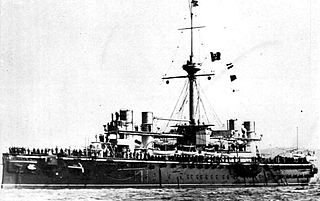
Lepanto was an Italian ironclad battleship built for the Italian Regia Marina, the second and last ship of the Italia class. Lepanto was laid down in November 1876, launched in March 1883, and completed in August 1887. She was armed with a main battery of four 432 mm (17 in) guns mounted in a central barbette and was capable of a top speed of 17.8 knots. Unlike other capital ships of the era, Lepanto had an armored deck rather than the more typical belt armor.

The Ruggiero di Lauria class was a class of ironclad battleships built for the Italian Regia Marina during the late 19th century. The three ships—Ruggiero di Lauria, Francesco Morosini, and Andrea Doria–were improved versions of the earlier Duilio-class ironclads. The primary improvements were new breech-loading guns, better armor protection, and more powerful machinery. The ships, designed by Giuseppe Micheli, marked a temporary diversion from the ideas of Benedetto Brin, who had designed the two preceding classes along with the following class.

Ruggiero di Lauria was an ironclad battleship built in the 1880s for the Italian Regia Marina. She was the lead ship of the Ruggiero di Lauria class, which included two other ships, Francesco Morosini and Andrea Doria. Ruggiero di Lauria, named for the medieval Sicilian admiral Ruggiero di Lauria, was armed with a main battery of four 432 mm (17 in) guns, was protected with 451 mm (17.75 in) thick belt armor, and was capable of a top speed of 17 knots.

Francesco Morosini was an ironclad battleship built in the 1880s and 1890s for the Italian Regia Marina. The ship, named for Francesco Morosini, the 17th-century Doge of Venice, was the second of three ships in the Ruggiero di Lauria class, along with Ruggiero di Lauria and Andrea Doria. She was armed with a main battery of four 356 mm (14 in) guns, was protected with 451 mm (17.75 in) thick belt armor, and was capable of a top speed of 17 knots.

Andrea Doria was an ironclad battleship built for the Italian Regia Marina in the 1880s and 1890s. Named for the 16th-century Genoese admiral Andrea Doria, she was the third and final ship of the Ruggiero di Lauria class. The ship was armed with a main battery of four 432 mm (17 in) guns, was protected with 451 mm (17.75 in) thick belt armor, and was capable of a top speed of 17 knots.

Piemonte was a unique protected cruiser built for the Italian Regia Marina in the 1880s by the British shipyard Armstrong Whitworth. She was the first major warship armed entirely with quick-firing (QF) guns and she was also the fastest cruiser in the world upon her completion in 1889. Piemonte was frequently deployed overseas, including a lengthy tour in East Asian waters from 1901 to 1904. She saw significant action during the Italo-Turkish War in 1911–1912 in the Red Sea, where she frequently bombarded Ottoman ports. During the Battle of Kunfuda Bay in January 1912, she and two destroyers sank four Ottoman gunboats and forced ashore three more. Piemonte participated in World War I but she saw little action during the conflict. She remained in service until 1920, when she was scrapped.
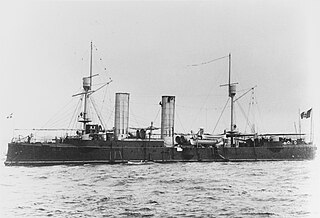
Dogali was a unique protected cruiser built for the Italian Regia Marina in the 1880s. Notably, she was the first warship equipped with triple-expansion engines. The ship was originally ordered by the Greek Navy and named Salamis, but she was sold to the Regia Marina before she was completed and renamed for the Battle of Dogali. She was armed with a main battery of six 15-centimeter (5.9 in) guns and reached a speed of 19.66 knots on her sea trials, making her one of the fastest cruisers at the time.

Etna was a protected cruiser of the Italian Regia Marina built in the 1880s. She was the lead ship of the Etna class, which included three sister ships. Named for Mount Etna on the island of Sicily, the ship was laid down in January 1883, was launched in September 1885, and was completed in December 1887. She was armed with a main battery of two 254 mm (10 in) and a secondary battery of six 152 mm (6 in) guns, and could steam at a speed of around 17 knots.

Stromboli was a protected cruiser of the Italian Regia Marina built in the 1880s. She was the second member of the Etna class, which included three sister ships. She was named for the volcanic island of Stromboli, and was armed with a main battery of two 254 mm (10 in) and a secondary battery of six 152 mm (6 in) guns, and could steam at a speed of around 17 knots. Her career was relatively uneventful; the only significant action in which she took part was the campaign against the Boxer Uprising in China in 1900. She returned to Italy in 1901 and spent the rest of her career in reserve or as an ammunition ship, apart from a brief stint in active service in 1904. Stromboli was stricken from the naval register in 1907 and sold for scrapping in 1911.

The EOC 10 inch 40 caliber guns were a family of related guns designed by the Elswick Ordnance Company and produced by Armstrong Whitworth in the 1890s for export customers. EOC 10 inch 40 caliber guns were the primary armament of armored cruisers, ironclads and pre-dreadnought battleships built or refit during the 1890s. These guns and their licensed derivatives armed ships of the Argentine Navy, Imperial Japanese Navy, Regia Marina and Spanish Navy. They served in the Russo-Japanese War, Italo-Turkish War and World War I.
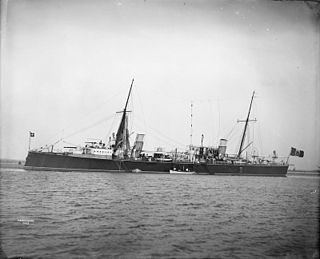
Calatafimi was a torpedo cruiser of the Partenope class built for the Italian Regia Marina in the 1880s. She was built by the Cantiere navale fratelli Orlando shipyard; her keel was laid in July 1891, she was launched in May 1894, and was commissioned in December 1895. Her main armament were her five torpedo tubes, which were supported by a battery of eleven small-caliber guns. Calatafimi spent most of her career in the main Italian fleet, where she was primarily occupied with training exercises. The ship was sold in March 1907 and broken up for scrap.

Folgore was a torpedo cruiser built for the Italian Regia Marina, the lead ship of the Folgore class. Armed with three 14 in (356 mm) torpedo tubes and six light guns, she was capable of a top speed of 17 knots. She was built in the mid-1880s, was launched in September 1886, and was completed in February 1887. The ship spent her first two years in service either conducting training maneuvers with the main Italian fleet or in reserve status. She was badly damaged in a collision with the cruiser Giovanni Bausan in 1889, which reduced her effectiveness and cut her career short. Folgore spent the next eleven years primarily in the reserve, until she was sold for scrap in April 1901 and broken up.

The 15 cm Schnelladekanone Länge 35, abbreviated as 15 cm SK L/35, was a German naval gun developed in the years before World War I that armed a variety of warships from different nations. The navies of Austria-Hungary, China, Denmark, Japan, The Netherlands, The Ottoman Empire, Romania and Spain all used this gun.
The EOC 8 inch 40 caliber were a family of related 8 in (200 mm) 40 caliber naval guns designed by the Elswick Ordnance Company and manufactured by Armstrong Whitworth for export customers before World War I. Users of this family of gun included the navies of Chile and Portugal.

The Canon de 100 mm Modèle 1891 was a French naval gun developed in the late 1800s that armed a variety of warships before World War I and during World War II. In addition to its naval role it was also deployed as coastal artillery.
The 15 cm/45 41st Year Type was a British naval gun designed by the Elswick Ordnance Company for export in the years before World War I that armed warships of the Imperial Japanese Navy. These guns served aboard Japanese ships during World War I and as coastal artillery during World War II.

The Gonzalez Hontoria de 12 cm mod 1883 was a Spanish naval gun developed in the late 1800s that armed a variety of warships of the Spanish Navy during the Spanish–American War.
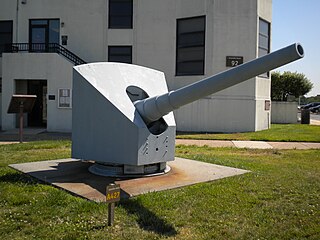
The Gonzalez Hontoria de 14 cm mod 1883 was a Spanish naval gun developed in the late 1800s that armed a variety of warships of the Spanish Navy during the Spanish–American War.
The Gonzalez Hontoria de 16 cm mod 1883 was a Spanish naval gun developed in the late 1800s that armed a variety of warships of the Spanish Navy during the Spanish–American War.
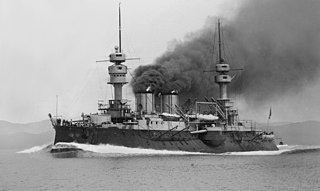
The Canon de 274 modèle 1887/1893 were a family of French naval guns developed in the years before World War I that armed a variety of warships of the French Navy. Guns salvaged from scrapped ships found a second life as coastal artillery and railway artillery during World War I and World War II.